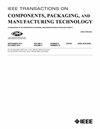A Method for Detecting the Initiation of Solder Joint Delamination in a 3-D PCB Assembly of WBG SiC MOSFET
IF 3
3区 工程技术
Q2 ENGINEERING, ELECTRICAL & ELECTRONIC
IEEE Transactions on Components, Packaging and Manufacturing Technology
Pub Date : 2025-07-30
DOI:10.1109/TCPMT.2025.3593891
引用次数: 0
Abstract
This article presents and discusses a method for evaluating the initiation of a solder joint delamination in a 3-D power electronics assembly of SiC MOSFETs integrated into printed circuit board substrate to design a more efficient half bridge. This assembly requires soldering two metallic parts and addresses the integration of active chips with small dimensions compared to the larger heat-sink dimensions to operate only with a convective cooling system. This technological development is part of an effort to assess the robustness of technological choices for a new assembly model of wide bandgap components. However, the conventional methods do not effectively meet the need for detecting the initiation of solder delamination due to the optimized electrothermal assembly design. The method relies on potential difference measurements that exhibit greater sensitivity to detect the onset of solder delamination. Finite element simulations are carried out to assess the method’s sensitivity and discriminating factors, such as geometry and materials involved. Based on the numerical results, the dedicated prototypes of the assembly are developed with controlled delamination rates at the solder joint corners. The results demonstrate that this method is sensitive to detect low delamination rates compared to the traditional method. An improvement of the PCB copper design is made by adding a routing to improve the robustness and the reliability of the method sensitivity.WBG SiC MOSFET三维PCB组件中焊点分层起始检测方法
本文提出并讨论了一种评估集成在印刷电路板基板上的SiC mosfet三维电力电子组件中焊点分层引发的方法,以设计更高效的半桥。该组件需要焊接两个金属部件,并且与较大的散热片尺寸相比,解决了小尺寸有源芯片的集成问题,仅使用对流冷却系统。这项技术的发展是评估技术选择的稳健性的努力的一部分,为新的组装模型的宽带隙组件。然而,由于优化的电热组件设计,传统的方法不能有效地满足检测焊料分层起始的需要。该方法依赖于电位差测量,表现出更高的灵敏度来检测焊料分层的开始。通过有限元仿真来评估该方法的灵敏度和判别因素,如几何形状和材料。在此基础上,开发了控制焊点角层脱率的专用组件原型。结果表明,与传统方法相比,该方法对低分层率具有较好的检测灵敏度。为了提高方法灵敏度的鲁棒性和可靠性,对PCB铜线设计进行了改进,增加了一条路由。
本文章由计算机程序翻译,如有差异,请以英文原文为准。
求助全文
约1分钟内获得全文
求助全文
来源期刊

IEEE Transactions on Components, Packaging and Manufacturing Technology
ENGINEERING, MANUFACTURING-ENGINEERING, ELECTRICAL & ELECTRONIC
CiteScore
4.70
自引率
13.60%
发文量
203
审稿时长
3 months
期刊介绍:
IEEE Transactions on Components, Packaging, and Manufacturing Technology publishes research and application articles on modeling, design, building blocks, technical infrastructure, and analysis underpinning electronic, photonic and MEMS packaging, in addition to new developments in passive components, electrical contacts and connectors, thermal management, and device reliability; as well as the manufacture of electronics parts and assemblies, with broad coverage of design, factory modeling, assembly methods, quality, product robustness, and design-for-environment.
 求助内容:
求助内容: 应助结果提醒方式:
应助结果提醒方式:


